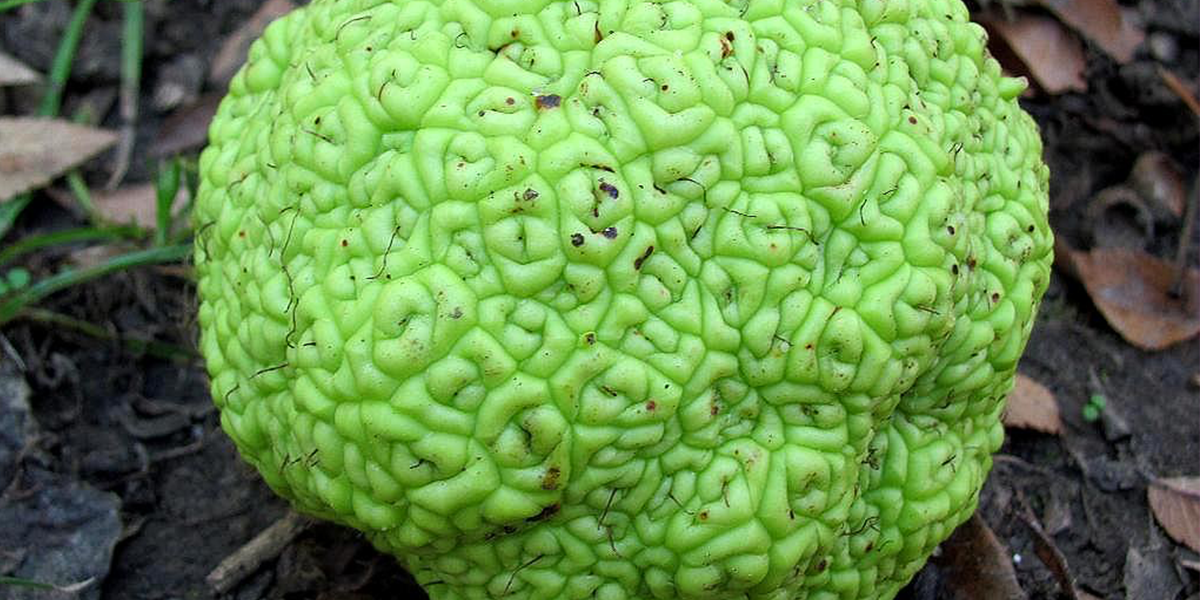The Changing Fortunes of the Monkey Brain Tree
- Oct 7, 2024

Giant, wrinkly green balls are ripening on trees in Cincinnati this month. Kids sometimes call them monkey brains. Other names for the thorny trees and their heavy fruit are Osage oranges, hedge apples, and Maclura pomifera. After a legendary decline, their epic comeback has returned them to our city after an absence of over ten thousand years.
Eons ago, between each advance of glaciers, the Osage orange trees grew in a huge area across North America, along with around seven now-extinct closely related species. We believe this because their pollen has been found buried in widespread ancient lake sediments, even as far north as Canada (Bronaugh 2010). Ancient horses, giant sloths, mastodons, and other big-mouthed beasts roamed here in those days. And a seed found in ancient mastodon poo seems to be an Osage orange seed (Newsome 2006). Maybe they’re the ones who ate the giant fruits and pooped out the fruits’ tough little seeds, planting the trees everywhere. Tough, springy branches and sharp thorns guarded the trees from the stompings and chargings of the great beasts.
By ten to thirteen thousand years ago, the horses, giant sloths, mastodons, and other giant fruit-eating seed poopers died out forever. Then the Osage orange tree slowly disappeared from most of its range, including Ohio.
By the early 1800’s, the last refuge of the Osage orange was in parts of east Texas and the edges of Arkansas and Oklahoma. Native peoples valued the strong, flexible wood for making the best archery bows, traveling hundreds of miles to get it. Some historians believe that the group who built the ancient city near Spiro, Oklahoma earned their treasure trove of wealth from guarding the groves of bow-wood trees and trading their wood through a vast network.
The tree became known to Americans after 1804, when Lewis and Clark sent a specimen to Thomas Jefferson. Farmers discovered that this tough tree made a great living fence to keep livestock inside of pastures or out of crop fields. Osage orange hedges were planted in farms across the country because they were “horse-high, bull-strong, and pig-tight.” The saplings were planted closely in a line and kept severely pruned back, with their tough, flexible, thorny stems woven together. In the long run, it was often cheaper and easier than building and replacing miles of fence made of boards and posts. Especially on the Great Plains where trees and lumber were scarce. Then in the late 1870s farmers were able to get barbed wire, and more and more hedgerows were abandoned.
Osage orange trees in abandoned fencerows and windbreaks across America have kept growing and dropping green balls, and now the Osage orange can be found in at least 39 states plus Ontario, Canada. It grows today in several Cincinnati parks that were once part of farms with Osage orange hedge-fences. There you can still find the trees with the big green balls today, returned to their ancient home, ready to feed the giant mouths that will never bite again.
Written by Cincinnati Parks Naturalist, Jonathan Duerbeck
Bronaugh, W. (2010, winter). The Trees that Miss the Mammoths. American Forests.
Newsom, L and M Milhlbachler. (2006). Mastodon (Mammut americium) diet and foraging patterns based on analysis of dung deposits. In S. D. Webb (Ed.) First Floridians and Last Mastodons: The Page-Ladson Site in the Aucilla River. Dordrecht: Springer Verlag.
